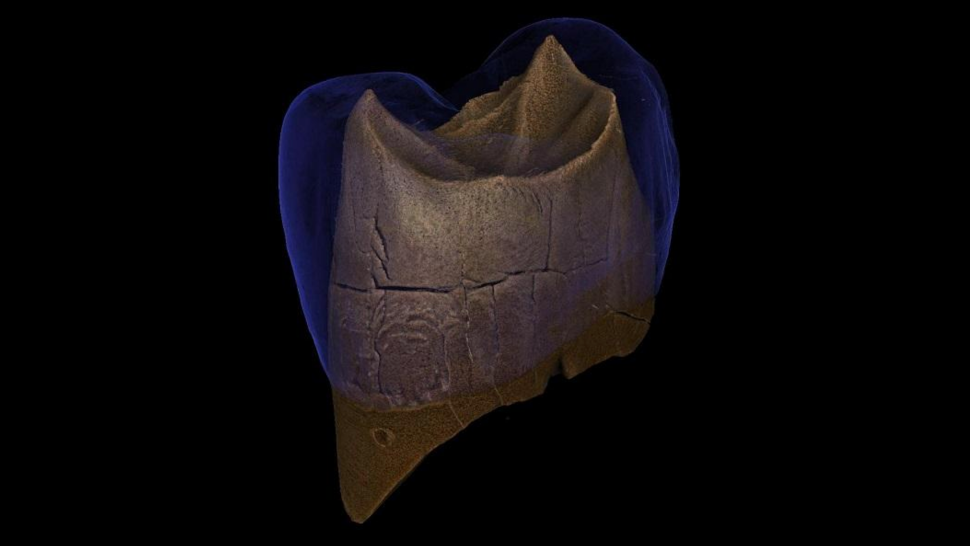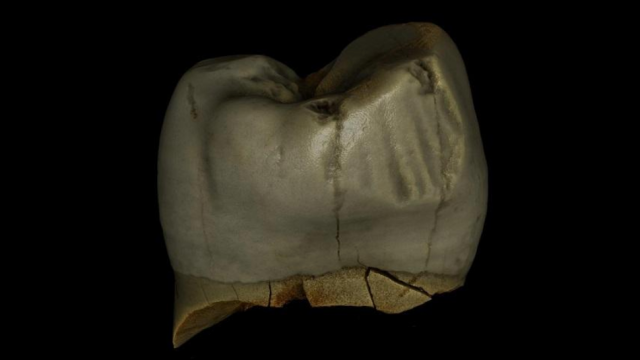Some 46,000 years ago in what is now the Polish highlands, a Neanderthal man got some food stuck between his teeth. So he did what any self-respecting hominin would do — he reached for a toothpick, according to new research.
The new paper, published in the Journal of Human Evolution, describes two teeth found in Stajnia Cave, located in the Polish highlands near Kraków and Częstochowa. The teeth were recovered in 2010 and kept at the State Archaeological Museum in Warsaw, and only now have scientists given them a thorough inspection.
A key finding of the new study are a series of toothpick grooves found on one of the teeth, in what is being interpreted as evidence of oral hygiene among Neanderthals. Toothpick grooves in Neanderthal teeth have been discovered before (including in Spain), but the new discovery suggests the practice was widespread among these extinct hominins.
The purpose of the study was to assess the two teeth — an upper premolar and a third lower molar (i.e. a wisdom tooth) — by conducting a physical examination and running a genetic analysis. It was a truly international effort, involving specialists from Poland, Germany, the U.K., and Italy. The new paper was led by Wioletta Nowaczewska from the Department of Human Biology at the University of Wroclaw.

Radiocarbon dating of the layer in which the teeth were discovered suggests they’re both around 46,000 years old. That’s a total of five Neanderthal teeth found in Stajnia Cave, the other three being molars, which also exhibited evidence of oral hygiene.
The same Pleistocene layer also contained evidence of stone tools (hafted in a known Neanderthal tradition called Micoquien) and more than 60 species of large and small mammals, as well as some birds. Each of the species discovered are known to have lived on the Late Pleistocene steppe-tundra, according to the paper.
The two teeth were in good shape, allowing for a digital reconstruction in both 2D and 3D. Neanderthal teeth differ from ours in several ways, including thinner enamel, which the scientists spotted in the two samples. Specific morphological patterns on the teeth, and an analysis of their associated mitochondrial DNA, also confirmed them as belonging to Neanderthals.
[referenced id=”1137653″ url=”https://gizmodo.com.au/2018/11/neanderthals-werent-the-violent-brutes-we-thought-new-research-finds/” thumb=”https://gizmodo.com.au/wp-content/uploads/2018/11/15/zsch9murpxz1qughu3cz.png” title=”Neanderthals Weren’t The Violent Brutes We Thought, New Research Finds” excerpt=”The stereotype of a typical Neanderthal life is that it was extraordinarily difficult, violent, and traumatic. But a comparative analysis of the remains left behind by Neanderthals and contemporaneous humans is finally overturning this unwarranted assumption.”]
The upper premolar belonged to an individual over 30 years old, while the wisdom tooth belonged to a male in his 20s. No evidence of oral pathology was detected, such as enamel growth disorders, hypoplasia (incomplete development), or cavities. The wisdom tooth showed significant wear and tear, likely the result of eating hard foods.
But the wisdom tooth also had signs of having been in contact with a toothpick.
“It appears that the owner of the tooth used oral hygiene,” explained Nowaczewska in an article by Science in Poland. “Probably between the last two teeth there were food residues that had to be removed.”
Nowaczewska and her colleagues aren’t sure what the toothpick was made from, but whatever if was, it had to be a “fairly stiff, cylindrical object, which the individual used often enough to leave a clear trace,” she said, referring to the detected toothpick groove. The toothpick could’ve been made from a piece of bone, perhaps a fish bone, or a twig, she said.
This is hardly the first evidence that Neanderthals were sophisticated people. Other research suggests they made art, wore jewellery, and cared for disabled loved ones.
